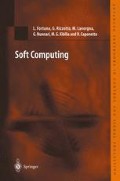Abstract
Artificial neural networks, fuzzy systems, and cellular neural networks are nonlinear systems. Furthermore, their use is directed towards the modeling and control of dynamic non-linear systems. Soft computing techniques would, in any case, be superfluous for studying linear systems, being more often than not dedicated to the study of systems having a certain degree of complexity. Hence the need to introduce the basic tools for analyzing complex dynamic systems. This chapter is therefore arranged around two themes: the first regards the analysis of complex dynamic systems, while the second deals with the processing of an innovative procedure for generating complex dynamics by means of CNNs and thus by means of soft computing types of techniques.
Access this chapter
Tax calculation will be finalised at checkout
Purchases are for personal use only
Preview
Unable to display preview. Download preview PDF.
References
TS Parker, Chua LO. Practical Numerical Algorithms for Chaotic Systems. Springer-Verlag, 1989
Eckmann JP, Ruelle D. Ergodic Theory of Chaos and Strange Attractors. Reviews of Modern Physics Part I. 1985; 57: 3
Thompson JMT, Stewart HB. Nonlinear Dynamics and Chaos. John Wiley and Sons, 1989
Lorenz EN. Deterministic Nonperiodic Flow. Journal Atmospheric Science. 1963; 20; 130
Rasband SN. Chaotic Dynamics of Nonlinear Systems. John Wiley & Sons, 1990
Hasler MJ. Electrical Circuits with Chaotic Behavior. 1 Proceedings of the IEEE, Aug. 1987
Ikeda K. Chaotic Itinerancy. International Symposia on Information Sciences, Ilzuka, July 1992
Gleick J. Chaos: Making a New Science. Viking Press, 1987
Mayer-Kress G,. Choi I, Weber N, Bargar R, H’bler A. Music Signals from Chua’s Circuit. IEEE Transactions on Circuits and Systems II. 1993; 40
Heileman GL, Abdallah C, Hush D, Baglio S. Chaotic Probe Strategies in Open Addressing Hashing. 1993 International Symposium on Nonlinear Theory and its Applications, Hawaii, Dec, 1993
Chaos Simulator and Application to Washing Machine, GOLDSTAR, Tech. Rep., July 1993
Dedieu H, Kennedy MP, Hasler M. Chaos Shift Keying: Modulation and Demodulation of a Chaotic Character Using Self-Synchronizing Chua’s Circuits. IEEE Transactions on Circuits and Systems II. 1993; 40
Bamsley MF. Fractals Everywhere. Academic Press Professional, 1993
Guckenheimer J, Holmes P. Nonlinear Oscillation, Dynamical Systems and Bifurcations of Vector Fields. Springer-Verlag, 1983
Fornasini E, Marchesini G. Appunti di Teoria dei Sistemi. Edizioni Libreria Progetto, Padova, 1985
Oseledec VI. A Multiplicative Ergodic Theorem. Lyapunov Characteristic Numbers for Dynamical Systems. Trans. Moscow Math. Soc. 1968; 19: 97
Haken H. At least One Lyapunov Exponent Vanishes if the Trajectory of an Attractor does not Contain a Fixed Point. Physics Letter. 1983; 94A(2): 71–72
Guillemin V, Pollack A. Differential Topology. Prentice-Hall, Englewood Cliffs 1974
Grassberger P, Procaccia I. Dimension and Entropies of Strange Attractors from a Fluctuating Dynamics Approach. Physica D. 1984; 13
Kaplan JL, Yorke JA. Chaotic Behavior of Multidimensional Difference Equations. Lecture Notes in Mathematics Springer-Verlag, 1979; 228–237
Badii R, Politi A. Statistical Description of Chaotic Attractors: The Dimension Function. Journal of Statistical Physics. 1985; 40(5/6): 725–750
Mayer-Kress G. (editor). Dimension and Entropies in Chaotic Systems. Springer-Verlag, 1986
Arena P. Baglio S, Fortuna L, Manganaro G. State Controlled CNN: A New Strategy for Generating High Complex Dynamics. IEICE trans. On Fundamentals October 1996; E79-A: 10
Arena P, Baglio S, Fortuna L, Manganaro G. Chua’s Circuit can be Generated by CNN Cells. IEEE Trans. On Circuits and Systems-Part I. February 1995; 42: 2
Arena P. Baglio S, Fortuna L, Manganaro G. Generation of N-Double Scroll Via Cellular Neural Networks. Int. Journal of Circuit Theory and Application 1966; 24
Geiger RL, Allen PE, Strader NR. VLSI: Design Techniques for Analog and Digital Circuits. McGraw-Hill, 1990
Arena P, Baglio S, Fortuna L, Manganaro G. Experimental Signal Transmission Using Synchronised State Controlled Cellular Neural Networks. IEE Electronics Letters. 1996; 32: 362–363
Caponetto R, Lavorgna M, Occhipinti L. Cellular Neural Networks in Secure Transmission Applications. 4th IEEE Int. Workshop on Cellular Neural Networks and their Appl.s, Seville, 1996; 411–416
Chua LO. (editor). Special Issue on Chaotic System, Proc. of IEEE. August 1987
Arena P, Baglio S, Fortuna L, Manganaro G. A Simplified Scheme for the Realisation of the Chua’s Oscillator by Using SC-CNN Cells. IEE Electronics Letters. 1995; 31: 1794–1795
Roska T, Wu CW, Balsi M, Chua LO. Stability and Dynamics of Delay-Type General and Cellular Neural Networks. IEEE Transactions on Circuits and Systems-I: Fundamental Theory and Applications, June 1992; 39: 6
Arena P, Baglio S, Fortuna L, Manganaro G. How State Controlled CNN cells generate the dynamics of the Colpitts-like Oscillator. IEEE Trans. on Circuits and Systems — part I, July 1996; 43
Kenney MP. Chaos in the Colpitts Oscillator. IEEE Trans.on Circuits and Systems — part I, 1994; 41: 771–774
Saito T. An approach toward higher dimensional hysteresis chaos generators. IEEE Trans. on Circuits and Systems 1990; 37: 399–409
Suykens JAK, Vandewalle J. Generation of n-Double Scrolls (n=1,2,3,4,). IEEE Trans. on Circuits and Systems — part I, 1993; 40: 861–867
Author information
Authors and Affiliations
Rights and permissions
Copyright information
© 2001 Springer-Verlag London
About this chapter
Cite this chapter
Fortuna, L., Rizzotto, G., Lavorgna, M., Nunnari, G., Xibilia, M.G., Caponetto, R. (2001). Complex Dynamics and Cellular Neural Networks. In: Soft Computing. Advanced Textbooks in Control and Signal Processing. Springer, London. https://doi.org/10.1007/978-1-4471-0357-8_8
Download citation
DOI: https://doi.org/10.1007/978-1-4471-0357-8_8
Publisher Name: Springer, London
Print ISBN: 978-1-85233-308-9
Online ISBN: 978-1-4471-0357-8
eBook Packages: Springer Book Archive

